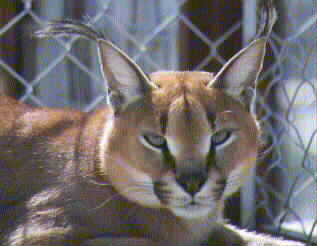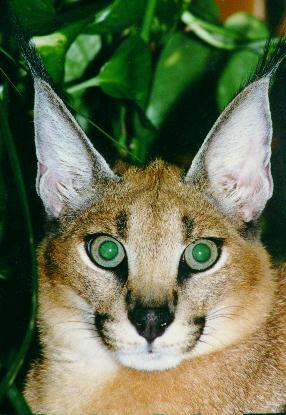Caracal
"Spock" in a basket at about 6 weeks of age.
The caracal, (caracal caracal),
(formerly aka felis caracal) is a sleek-bodied cat with long pointed ears
ending in black tufts of straight hair. In some areas it is known as the
'desert lynx'. The name 'caracal' comes from the Turkish word 'karakal'
which means 'black ear'. These tufts can reach nearly 2-3 inches long! Females
can weigh about 30 lb. at maturity, while males can reach 40-50 lb. They
are normally 40-45 cm (16-17 inches) tall at shoulder height with a head-body
length of 66-76 cm (26-30 inches). Males have a broader, rounder head and
heavier body. Colors and even size are variable by origin. They can range
with a base color of light cream through golden and up to a very dark rust.
I have heard of some melanistic caracals in Ethiopia. The underbelly is
off-white to cream most often with spots. Their fur is thick and short with
white hair on the underside of the jaw, throat and down through the undersides.
They have an ample supply of beige colored und! erco at during the cold
months.
The mouth is edged with black skin. There is white eye-shadow under each
eye which itself is edged black eye-liner. Each cheek has a white patch
on the jaw line. There are black markings on the face as follows: from the
inside corner of the eye to the black nose, from the top of the inside of
the eye straight up the forehead and from the middle of the forehead between
the two upper lines from the eyes. The whiskers are short and light colored
and embedded in a black area on the muzzle. The tail is one-third the length
of the head and body and is lightly tipped with black.
The anterior premolar is absent in the upper jaw.
We have seen the following types of coloration: Cream with black markings;
Cream with light markings; Golden brown with black markings; Silver tipped
with dark markings; Red with dark markings; Dark red with dark markings.
Eye color can vary from light brown, gold, light green/gray, light blue
green, and light blue gray.
They were originally from India, Afghanistan, Iran and nearly all of Africa.
Caracals are found in arid to semi-arid woodlands and savannas including
scrub areas where they stalk and ambush their prey of birds, small mammals,
and baby antelope. They will also eat insects. They are solitary, nocturnal
and excellent climbers. They are easily tamed and have been trained for
hunting in India and Iran. At one time they were pitted against each other
in games of pigeon catching and those attending the spectacle wagered for
one or the other. The caracal disabling the greatest number of pigeons in
the allotted time was declared the winner. Caracals were also used to hunt
hares and various birds such as peafowl, cranes and crows.
Caracals are highly intelligent cats and the fastest cat of their size.
The one and only "Bubba", happy in his job as one of our
good stud cats.
They are sexually mature at 6
to 18 months but usually do not breed until 2 years of age. Litters can
be 1-6 and are weaned at 3-5 months of age. Gestation is 69-78 days. They
are born in abandoned burrows. The kittens emit a cheeping sound for their
mother very similar to that of the young of the cheetah. As they get older,
they are a quiet animal, making a cry similar to a leopard when they are
in distress. When disturbed, they can growl, hiss and spit. They are long
lived in captivity, with life spans over 18 years recorded.
"The Dude" is 2 years old and one of our best stud cats.
He is red and has a magnificent head and ear tufts.
In Captivity
Caracals are not difficult to
keep in captivity especially if they are hand-raised. We have found that
caracals that were mother-raised in captivity have little fear of humans
and could be dangerous if not properly handled and housed. Caracals will
imprint on the person(s) who raise and feed them. If not properly socialized,
these cats may not accept strangers. We have never seen one who will attack,
however, the possibility is there. As pets, an owner needs a deep understanding
of their nature and why they do the things they do. They are highly trainable
cats and can perform amazing feats of leaping and jumping to catch toys
they like. They are highly motivated by positive reinforcement. We are currently
training some with the CLICKER method and so far have been very successful.
More about this at a later time. Caracals have a very strong prey drive
and are relentless about any movements- bugs, mice, etc. They are wonderful
at keeping a house free of mice and inse! cts. Rodenticides should not be
used in an area where there are caracals or other cats. They may find a
dead or debilitated rodent that has consumed the poison. It could be deadly
to the cat. Caracals are capable of leaping 8 feet into the air. Our house
caracals have easily jumped from a stand-still to a shelf that is 7 feet
from the floor in our house.
They need an owner who keeps track of their whereabouts at all times. Many
household pesticides and chemicals are extremely toxic to any feline, sometimes
to the point of death. Dog products cannot be used on them for fleas, etc.
You must animal proof your home before you add an exotic cat or even domestic
cat to it.
All exotic cats should be trained to a leash and collar or harness when
it is young so they will be able to be taken on take walks outside. You
may never let an exotic cat run free outside, even in your own back yard.
Karmel is my house caracal. She lays on my scanner when I'm
computing and shares my bed at night. Her eyes (special cells on the retina)
reflect surrounding color. Here her eyes reflect the green of the plants.
These animals must be neutered to curb behaviors related to sexual
hormone stimuli.
These cats need lots of play time due to their highly predatory nature.
Games can be played with them that will help curb these natural predatory
behaviors. They must have an outlet for their energy.
They must be socialized as kittens or they will remain hidden when strangers
are present. They may stalk or watch young children. Caution must be exercised
at all times with these cats and they must never be taken for granted.
We give full detailed diet and care instructions with all kittens we produce.
Additional Photos:
One of our ladies just waking up from an afternoon
snooze.
Don't ever forget I am a wild animal!
R-Zu-2-U Home
R-Zu-2-U FAQs
R-Zu-2-U Animal "Terms"
Treasure Ranch Home




